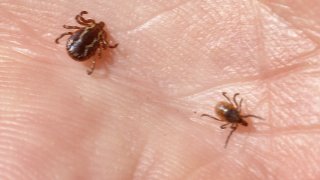
The University of Maine’s tick lab found that a higher percentage of ticks tested positive for the pathogen that causes Lyme disease last year than the previous year.
The University of Maine Cooperative Extension Tick Lab said recently that the rate of infection for Lyme disease grew by almost 6%. The 2021 rate was a little more than 42% while a year prior it was just under 37%.
The lab said infection rates for anaplasma and babesia, which are other pathogens carried by ticks, also increased by a few percentage points. The lab said it received nearly double the number of tick submissions in 2021 than it did in 2020.
Griffin Dill, who manages the lab, said the increase in submissions was driven by a large number of submissions of American dog ticks. Those aren’t known to transmit pathogens in the state.
Get New England news, weather forecasts and entertainment stories to your inbox. Sign up for NECN newsletters.
Nearly half of deer ticks tested positive for at least one pathogen, tick lab said. Deer ticks can transmit Lyme disease and other infections.
Typical symptoms of Lyme disease include fever, headache, fatigue and a skin rash, according to the Centers for Disease Control and Prevention. Without treatment, it can spread to the joints, heart and nervous system.




